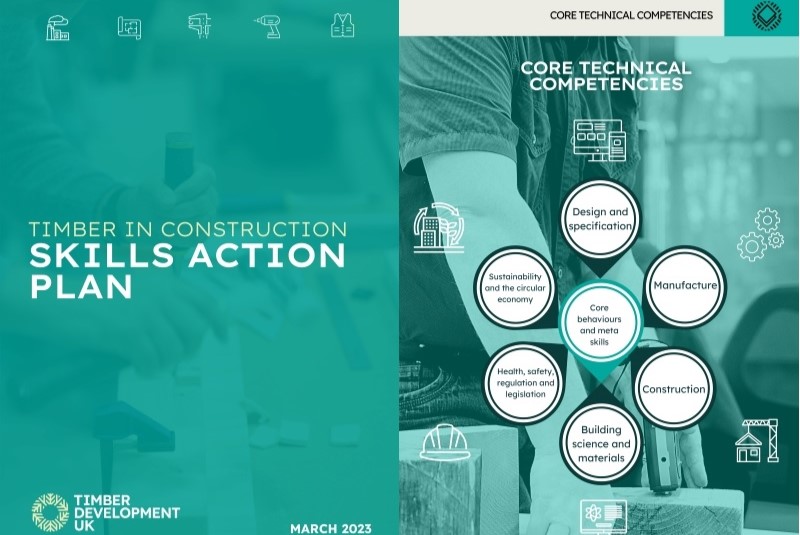
Timber Development UK has unveiled a comprehensive Skills Action Plan aimed at equipping the construction industry with the skills to increase the use of timber and achieve net-zero targets. David Hopkins, TDUK Chief Executive, explains the rationale behind the plan.
The construction industry is responsible for almost 40% of global emissions and consumes half of all materials extracted from the environment. As a result, it faces a steep climb to achieve its net zero targets as one of the worst-performing industries. To reduce these figures and significantly reduce its carbon emissions, experts have identified the use of timber as a key solution.
For example, engineered products such as cross-laminated timber can capture and store carbon within the built environment, resulting in a potential net benefit of 754CO2/m2 reduction compared to other forms of construction.
Timber Development UK has produced a Timber in Construction – Skills Action Plan, in partnership with the HCI Skills Gateway, Edinburgh Napier University and NMITE, which provides an industry-agreed breakdown of the skills and knowledge required for building with timber.
The plan will aid the development of training programmes across the timber supply chain and also support Continuing Professional Development progression, giving built environment professionals a better understanding of how to incorporate timber into their building designs.
Tackling the skills shortage
Such skills are badly needed. The UK construction industry employs 3.1 million people, yet the skills crisis means we need at least 350,000 more full-time workers over the next decade to deliver the built environment’s ambitions. At present, too few professionals have the skills, knowledge and confidence to work confidently with timber.
Timber is lightweight, easily workable, and can be processed efficiently using modern methods of construction, reducing waste and improving productivity. This provides solutions for affordable, energy-efficient housing, national retrofit targets, and net-zero public sector buildings. With the launch of the Timber Skills Action plan, the UK construction industry can take a significant step towards achieving its net-zero targets and reducing its impact on the environment.
To achieve this, we worked with a coalition of partners across industry, academia and funders to create the competency framework that sits at the heart of the plan. Accordingly, a number of core technical competencies are identified which apply across the timber supply chain:
Design and specification
Sustainability and the circular economy
Core behaviours and meta skills
Manufacture
Health, safety, regulation and legislation
Construction
Building science and materials.
Within each of these competencies, the plan sets out the knowledge and skills that are considered important for those working within these areas. This is intended to enable companies across the timber supply chain to consider whether or not their current workforce has all the competencies they need, and develop training programs to address any gaps.
The framework already underpins a set of short, practical courses developed by NMITE’s Centre for Advanced Timber Technology (CATT), in partnership with TDUK. These Timber TED (Technical Engineering & Design) courses provide comprehensive and flexible training for modern timber construction methods, enabling professionals to upskill and reskill in this critical area.
Our ambition is that the Timber in Construction – Skills Action Plan will support every built environment professional to identify and address timber skills and knowledge gaps so the industry can make the best possible use of timber in construction.
Timber provides a ready-made solution that doesn’t rely on greenwashing, speculative innovations, or progress in other industries to deliver genuine carbon savings in the short and medium term. We now need the construction sector and government to hear this call to action. As Kirsty Connell-Skinner, Programme Manager at the HCI Skills Gateway, said: “This plan, led by HCI Skills Gateway using Scotland’s best practice, is an important step in the development of the UK-wide timber construction trade, as it allows us to set a national mission for the industry.
“The four UK nations have achieved different standards and progress within the sector, but this action plan has been built on the best practice, learning and thorough research by a strong group of partners, and serves as a collaborative way of moving forward.”
The Skills Action Plan has been published online as an open access resource available to anyone interested in improving their timber skills. The plan is an industry-agreed definition of what a skilled construction practitioner should know and be able to do when building with timber.
Click here for more information from Timber Development UK.
Timber Development UK (TDUK) has also launched the Structural Timber Price Index to help the construction industry assess changes in the UK timber market.
Displaying the monthly price of structural timber stretching back to 2018, the Index gives users the ability to compare today’s timber prices to those seen five years ago — a time that was pre-Brexit, pre-Covid and pre-War in Ukraine, making them arguably the most recent ‘normal’ year and therefore a sensible point for comparison.
Nick Boulton, TDUK Head of Technical and Trade Policy, explained: “The TDUK Structural Timber Price Index is a powerful new tool for the construction industry to understand the state of the timber market in the UK. Timber is a globally traded commodity and the UK is a major importer of structural timbers, so large geopolitical events can ripple across the trade.
“The abnormal structural timber prices we have seen over the past three years reflect the abnormal market we have all lived through. However, the three most recent months shown on the index — from November 2022 to January 2023 — are among the most stable price periods we’ve seen since 2019, which likely reflects the balance between supply, demand, and price.”
Nick added: “While no one can predict the future, the commodity market for structural timbers has historically been a steady, and dependable one. We will be watching the market carefully to see whether this trend will be re-established.”
Click here to view the Structural Timber Price Index, along with many other timber statistics from TDUK.









